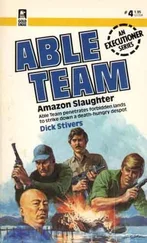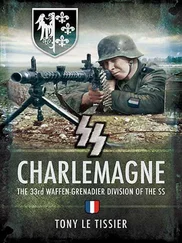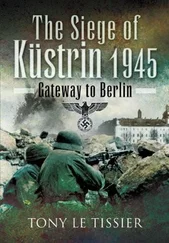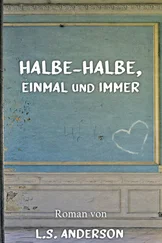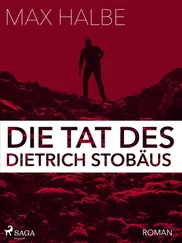The battalion commander and his staff were on the south side of the street dividing Halbe in two and were looking south across the pasture to the woods, where white flags were waving among the trees. The battalion commander turned to me and said: ‘Corporal, you speak German, don’t you? You see the white flags? It’s less than a kilometre. If you want to earn the “Red Banner”, [2] The second highest Soviet decoration after the Order of Lenin.
go and clarify the situation and bring back some delegates for their surrender with you.’
I started across the pasture but had gone only about 200 metres when the flags disappeared and several gunshots sounded from the woods. There was no one to be seen, and my battalion commander and his staff had also disappeared, so I returned to my section.
Then a runner appeared: ‘German tanks are moving towards the village with infantry following them!’ The pasture immediately became alive with attacking German infantry. We held our fire until 200 metres then started mowing them down, forcing them to retreat. But it was bad behind us, where the German tanks were rolling forward with machine guns firing from their turrets and followed by infantry assault teams. The supporting 45-mm gun sited on the pavement was unable to stop them and was hit by a shell from a Tiger that wrecked it and killed the crew. We were taking casualties and tried to withdraw but were pinned down until dusk, which came suddenly and enabled us to crawl out of Halbe with our wounded. The battalion commander had been killed and the whole battalion was in retreat. [3] Adapted from Harry Zvi Glaser’s account in the author’s With Our Backs to Berlin .
An SS-sergeant-major of the 32nd SS Motorized Signals Battalion reported:
At 0200 hours on 28 April our unit ceased to exist. We were split up into infantry combat teams. Our team was led by the unit administrative officer, our commander having already said his goodbyes and wished us good luck in the break-out. During the break-out attempt we were separated and I only had my runner with me. It was chaotic.
I had never been so astonished during the whole of the war as I was that morning of 28 April. What I saw in the column left me speechless, changing to blind rage, anger and aggressiveness. There were officers and their drivers sleeping peacefully in their vehicles with their legs over the folded-down windscreens. Others were eating breakfast with appetite, even small fires could be seen for heating coffee. A peacetime scene, while several hundred metres away death was reaping a rich harvest. While mini combat teams were trying to effect a breakthrough, thousands of men here of all ranks from the Army, Waffen-SS, Luftwaffe and Flak were lying around and waiting for the others to smash through the encirclement so that they could drive out in peace and quiet. No officer made any attempt to form a combat team out of this lot. A flak captain was having a shave by his vehicle with his field tunic hanging neatly from a coathanger on the vehicle. A large number of these ‘comrades’ had to pay for this attitude with their lives or long years of imprisonment under the Soviets… it was just a leaderless horde. [4] Wilke, Am Rande der Strassen , p. 63.
The troops began to desert, flee and panic. Command and control were lost and many soldiers decided to strike out on their own. That morning 9th Army lost some 3,000 prisoners, 15 tanks and over 60 guns, and an unknown number of dead and wounded.
Once more the 1st Guards Artillery Breakthrough Division, with its 300 guns deployed south of Halbe, played a decisive role in the Soviet success. There was no way for the encircled troops to match this mass of artillery, as an inhabitant of Teupitz recalled:
I had experienced the bombardments in Champagne during the First World War, taken part in the Battle of the Somme and been in the bitter ring at Verdun, but what occurred in the Halbe cauldron during these days put all that I had seen before into the shade. With clockwork precision, all day long until dusk one bomber squadron after another brought its deadly loads to the big woods around Halbe, Teupitz and Märkisch Buchholz and dropped them on the fully congested country roads. Without a pause the rockets hissed in and the guns hammered at the makeshift positions the German troops had dug. [5] Domank, The 1st Guards Breakthrough Artillery Division at Halbe’; Lakowski/Stich, Der Kessel von Halbe 1945 , p. 108.
That morning, in accordance with orders issued by Marshal Koniev the night before, 3rd Guards Tank Army in Berlin launched a concerted attack on the extreme right wing of its area of operations in Schöneberg with the aim of crossing the Landwehr Canal by nightfall. The main attack got under way as planned and it was not until sometime later in the morning that it was suddenly realised that virtually the whole of the eastern half of their proposed line of advance was already occupied by Chuikov’s troops, for whom the weight of Koniev’s artillery preparations could hardly have been welcome. The emotions that this event raised can well be imagined. [6] Koniev, Year of Victory , p. 184; Erickson, The Road to Berlin , p. 600. Koniev was still aiming for the Reichstag.
Koniev, however, barely mentioned this incident in his memoirs:
Meanwhile, during the morning, Chuikov’s 8th Guards Army, Rybalko’s neighbour on the right, resolutely advanced west, all the way to the southern bank of the Landwehr Canal, and reached the Anhalter Railway Terminal, Lützowplatz and the intersection of Plauener Strasse and Maassenstrasse.
In view of the rapid westward advance of Chuikov’s troops and in order to prevent Rybalko’s 9th Mechanized Corps from getting mixed up with Chuikov’s 8th Guards Army, I ordered Rybalko that, after he had reached the Landwehr Canal, he should turn his most advanced units west and continue his advance in the zone of operations newly established by that time for the 1st Ukrainian Front. [7] Koniev, Year of Victory , p. 184. The only Plauener Strasse then and now is in Hohenschönhausen in north-east Berlin. Koniev probably meant Pallasstrasse.
One assumes that General Chuikov’s thrust westwards across the inter-front boundary could only have been effected with Marshal Zhukov’s connivance, and there was no way that 3rd Guards Tank Army was going to be allowed to close up to the Landwehr Canal. However, at midnight Moscow time GHQ issued orders for a new inter-front boundary, which diverted 3rd Guards Tank Army in a north-westerly direction, well away from the city centre.
With his Berlin ambitions thus thwarted, Koniev left General Rybalko to complete 1st Ukrainian Front’s role in the city as best he might. Koniev had taken a tremendous gamble in concentrating all his available resources in a single powerful thrust on the Reichstag, but had been defeated by factors arising out of the rivalry between himself and Marshal Zhukov – which had been skilfully exploited by Stalin without regard for the military implications. [8] Koniev, Year of Victory , p. 187.
The Halbe pocket had now been reduced to a sixth of its original size, the steadily growing threat by the four Soviet armies surrounding them giving the encircled concentration of troops and refugees no peace. Constant fighting was taking place on the perimeter while bombers and ground-attack aircraft struck from above whenever the weather allowed, and the fire from artillery, mortars and rockets continued to take a steady toll.
From Prieros, now the northernmost tip of the pocket, the company-sized combat team of 1st Battalion, 86th SS Regiment Schill , conducted an unsuccessful counterattack against the Soviets occupying Kolberg, but was able to hold its ground on the necks of land between the lakes in that area. Its left-hand neighbour, the combat team of 87th SS Regiment Kurmark , covering the line Neubrück–Prieros, was decimated by an attack, backed by aerial bombardment, by Soviet armour coming from Klein Köris. Behind it along the line Schwerin–Hammer–Hermsdorf–Gross Eichholz were combat teams formed from elements of Panzergrenadier Division Kurmark and 32nd SS Field Training and Replacement Battalion of 32nd SS Division under the overall command of SS-Colonel Kempin of the latter formation. [9] Wilke, Am Rande der Strassen , p. 48.
They were attacked by Soviet forces and Seydlitz-Troops .
Читать дальше

